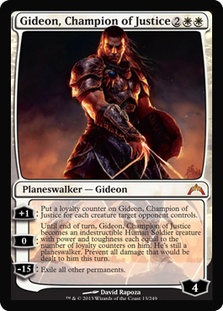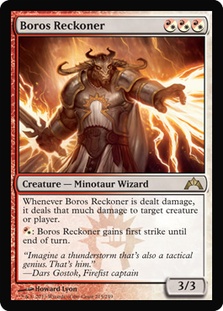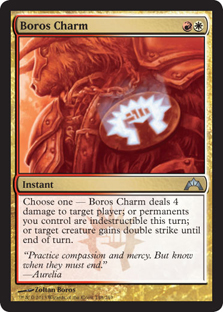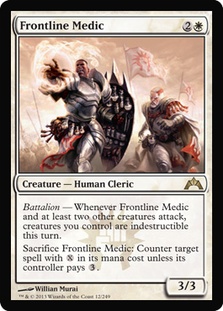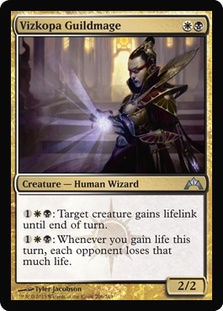Deckbuilding is an art, and like any art, it requires regular practice. People often ask how I learned to build decks, and I always reply that I’ve been doing it forever. Recently, my writing has forced me to build a lot more decks, which I think has resulted in me getting better at it very quickly. It’s said that if you want to be a writer, you need to write every day, but people still go to school to learn how to do it. Practice is great, but you need to know how to practice properly.
1. It’s OK To Build Bad Decks
If you’re preparing for an important tournament, it’s not a good idea to build something different just because it’s different, but if you’re just building for practice, it’s a different story. A great way to practice is to try to build a deck that is identifiably unique (don’t just add a card to an existing deck—find a card, interaction, or strategy and build a deck around it from the ground up), play the deck (I’d say around five Magic Online two-player queues), and update it, but don’t get attached if it doesn’t pan out.
Make yourself do this every day or week or whatever you have time for, but definitely regularly. Remember, it’s more important to build something than to build something awesome, but once you have an idea, you should try to make it competitive.
2. Focus On Looking At Pieces Rather Than Wholes
Train yourself to pay attention to which cards and interactions are working well in decks you and others play and to think about when you might be able to extract this package to include it in another shell. It’s easy to identify that Thragtusk is a good card and that it plays well with Restoration Angel. You can learn this by watching a Naya Midrange deck, and then you can port it into a Bant Control shell.
This is obvious at this point, but if you learn to look for it, you may find other cards that can play well outside of their usual homes. For example, Olivia seemed to win a lot of games by itself when various Jund decks played it, but since it didn’t need any help, it was clear that it could work in any deck that had the mana, so I built the sideboard of my Rakdos Aggro deck for Grand Prix Atlantic City around Olivia.
It’s also useful to think of packages of two to four cards that you generally want to play together; then you can build decks around these packages. For example, if you’re going to play Snapcaster Mage in Standard, you probably want Thought Scour to make sure you have targets, and you’re likely to want some combination of Restoration Angel, Augur of Bolas, Think Twice, and Unsummon. These cards all feed off each other, and they can all fit in a variety of decks.
I often see players who are resistant to new ideas dismiss everything about a deck because it has a few bad or obviously wrong cards. The idea is that if someone was stupid enough to put a card they know is bad in a deck, there’s no reason to listen to their ideas. This just cuts off information, and if the deck has had any success, the thinking is exactly backwards. If you know a deck is built badly and it’s doing well anyway, there must be something really good going on that’s letting it win anyway. If you fix that, you might have something amazing.
A deck contains a lot of ideas. Don’t think of a list as a single idea. Learn to separate the good ideas from the bad ideas contained in a single list.
3. Look For Conventional Wisdom That Might Not Be Correct
Early in my deckbuilding career, I strongly disagreed with conventional wisdom about how many copies of a card should be in a deck. People were (and still are, but not nearly as much) very resistant to playing fewer than four of a card or playing one of a card without a specific way to search for it. If there is a very limited pool of good cards, of course you want to play as many of them as possible, but if many cards are similarly powerful, splitting them seems very good to me.
Any time you’re debating between playing four of card A or four of card B and it’s close, it might be correct to play two of each. The law of diminishing marginal returns is a very real thing in Magic, and a greater variety of cards in your deck will generally give you more options in play, which is a good thing.
Land counts, curves, and the ranges of the kinds of spells that can be good are all areas that people have extremely strong biases about. Auras were generally considered more or less unplayable for a long time, so the various hexproof aura decks generally look like joke decks even today after they’ve been very successful. There are biases that everyone takes into their deckbuilding that you can learn to remove.
The Door to Nothingness deck is an example of a deck that largely goes against conventional wisdom that would simply be out of the range of most deckbuilders to consider.
4. Know The Cards
How can you build if you don’t know the tools? I follow every new set very closely as it’s spoiled and read the visual spoiler several times so that by the Prerelease I can usually identify most cards at a glance. After that, I draft enough to solidify each card in my memory. If you don’t do this, learn to get very good at using card searches to find anything that might be useful and reading through long lists of cards whenever you build something.
5. Look For Inspiration Whenever You Play
A lot of my ideas for Constructed come from playing Limited. Sometimes playing with a card in Limited will make it clear that it’s a lot more powerful than I expected. Over enough games, most combos contained within a single set will come up in Limited; seeing them in a context where they can shine will have you considering which ones might be strong enough for Constructed. I wouldn’t be surprised if Invisible Stalker + Runechanter’s Pike in Standard was originally inspired by a draft.
6. Cards, Interactions, and Strategies
Deckbuilding should be a combination of maximizing the best cards, interactions, and strategies available to you. These aren’t random buzzwords; these are real, concrete things that are each distinct and important in deckbuilding.
You need to identify which cards are individually powerful enough to be worth playing on pure stand-alone power.
Example: I think Gideon, Champion of Justice might be a lot better than people realize, so I should build a deck with it.
You need to identify when multiple cards can interact to create an effect that is relevantly greater than the sum of its parts. Restoration Angel + Thragtusk is ideal because it’s a powerful interaction that consists of individually powerful cards, as opposed to Vizkopa Guildmage + Exquisite Blood, which is a more powerful interaction but requires playing cards that are much weaker individually. Both of these kinds of interactions are important to look for when deckbuilding.
Example: Gideon, Champion of Justice plays very well with Jace, Architect of Thought because they let your opponent have a lot of creatures in play without making any real progress.
The final important thing to look for is when a format is vulnerable to a particular strategy, possibly because it’s not supported well, leading to it not being played, which means people don’t prepare for it. There will also be times when a metagame just happens to move away from acknowledging a certain strategy.
It’s important to keep an eye out for times when everyone is playing (for example) midrange creature decks that are very vulnerable to sweepers or strategies that go over the top, like Door to Nothingness or Tooth and Nail.
Example: I think a planeswalker-based control deck might be well positioned right now because people are playing relatively slow creatures that don’t effectively threaten a control deck like Thragtusk, Olivia Voldaren, and Huntmaster of the Fells.
7. Research
You won’t always find every interaction by yourself. If you pay attention to preview articles, strategy articles, forum discussions, Twitter, and anywhere else where people discuss cards, you’ll hear ideas for cool combos that you might not have considered. I imagine a lot more people learned about the Boros Reckoner + lifelink (Azorius Charm / Nearheath Pilgrim) + indestructibility (Boros Charm / Frontline Medic / Rootborn Defenses) combo via Twitter or reading about it than from thinking of it themselves.
Once you have a combo like that, it can be an excellent source of inspiration that slots itself into a variety of decks.
The U/W Delver-less Midrange deck I built last season was inspired by a tweet that Gideon and Tamiyo work well together.
8. Learn To Build From The Ground Up Rather Than Just Modifying
Sometimes when I’m watching someone and they play a card that isn’t widely played, like Hound of Griselbrand in a Mono-Red Aggro deck, someone watching will ask, “What did you cut for that?”
This question makes sense if both people shared an exact list and the person asking wanted to know how it changed, but too often people assume there’s a certain “stock list” and expect everyone to build from it. This is generally a deck that’s done well or has been written about.
I feel like this question illustrates some false assumptions about how decks construction works. I would be much more comfortable with, “How does that deck differ from ____?” I just don’t like the assumption that all decks were built by modifying some starting point rather than by choosing the cards that do what you want to do.
If your approach is to take an existing list and modify it by cutting something to make room for a card you want to play, you might fail to correct a card choice that was made based on an interaction with the card you cut.
9. Don’t Be Afraid To Evolve A Deck Away From Its Original Purpose
I’ve been working on a wide variety of Orzhov decks in my preparation for Pro Tour Gatecrash. It started with trying to build an Orzhov deck for my Daily Decks feature on the mothership, where I used Vizkopa Guildmage with Exquisite Bond. That deck morphed and split into a variety of decks, including an aggressive Human deck and an aggressive Zombie deck, neither of which really has any resemblance to the original deck. It’s barely accurate to call them evolutions from that deck, but both of them were inspired by working on that deck and thinking about the synergies that exist in those colors.
Sometimes, you can completely change colors or strategies. Sometimes, someone will make a joke along the lines of, “Well, this Glistener Elf is pretty good, but I think Delver of Secrets is a better one-drop. I see that you have Apostle’s Blessing, but maybe you should cut it for Mana Leak, which is a better counterspell. This might of Old Krosa is a good pump spell, but maybe it would be better to play Runechanter’s Pike, which will help every turn,” etc. to discuss how they don’t like a certain deck with the implication that it’s strategically dominated by a completely different deck. Sometimes, evolutions like that happen naturally, and you can just go with them.
The Blazing Shoal deck I finished 3rd with at Pro Tour Philadelphia started out as Goblin deck that was using Blazing Shoal with Greater Gargadon to make Warren Instigator lethal, but John Stolzmann, the designer, decided that the Blazing Shoal kill was better than the Goblin part of the deck, so he focused on that, finding infect as a good source of double strike.
10. When It Matters, You Don’t Have To Be Cute
All of this was about learning to practice to become a deckbuilder, but if you want to use it to become a successful tournament player, you have to understand that there are times when the community just has all the best decks or when you don’t have time to find something radically new. It’s ok to work from a stock deck or even to play a stock deck if that’s what you need to do for a tournament. It just isn’t great practice to learn to build new decks in the future.
Now I need to get back to trying to build something new for this Pro Tour.
Thanks for reading,
Sam
@samuelhblack on Twitter

